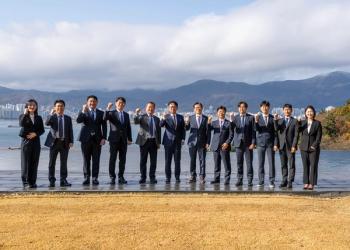
Shale gas bonanza triggers new projects in the U.S.
Four LNG trains are being built across the U.S.
Exploitation of unconventional energy sources, such as shale gas, coal-bedmethane and oil sands, is creating abundant energy development opportunities inthe U.S. So much gas available at bargain prices is triggering a rapid rise in new projects, such as pipelines, chemical process plants and ethylene crackers. That's good news for those manufacturing, repairing and servicing gas turbines, centrifugal compressors and microturbines.
Influence on energy markets
The shale gas bonanza is already influencing energy markets. The U.S. Energy
Information Administration (EIA) noted that pipeline gross imports of natural
gas fell by 4.1% to 8.7 Bcf/d (billion cubic feet per day) during 2011, and that
they are expected to fall to 8.4 Bcf/d in 2012. Specific to U.S. imports of LNG, they fell from 1.2 Bcf/d in 2010 to 1.0 Bcf/d in 2011. At the same time, pipeline gross exports to Mexico and Canada were averaging 4.1 Bcf/d in 2011 and
that should rise to 4.2 Bcf/d in 2012, compared with 3.1 Bcf/d in 2010. This
could signal the end of the U.S.'s long dependency on foreign gas supplies.
James Hackett, CEO of Anadarko, said the U.S. produces more natural gas
today than Russia, and that there are more shale gas energy reserves in the
country than Saudi Arabia has oil reserves. To quantify that, the EIA has ramped
up its gas reserves estimate to 2,552 Tcf (trillion cubic feet) of which shale
makes up one third. Ten years back, it made up 1%. Within 20 years, the EIA
expects shale gas to contribute half of all U.S. gas production.
Forecast International's Bill Schmalzer said, "The fastest growing source of primary energy is projected to be natural gas through 2015. The increased
domestic onshore exploration and production are likely to keep prices below $5
for the next decade." LNG exporting, pipeline compression, and the chemical process industries will be among the big winners in the shale gas boom. In each case, large amounts of new or re-rated turbomachinery are required.
LNG exports
As a result of the gas glut, many of the dozen or so poorly utilized Liquefied
Natural Gas (LNG) import facilities that dot the Eastern and Gulf seaboards of
the U.S. will be converted into export terminals to transport gas resources to
Asia, Europe and elsewhere. Currently, these sites are engineered to receive LNG
from abroad and re-gasify it for U.S. markets. The switch to exports, however, requires a different setup as well as more pipelines to take gas to the coast, and this translates into massive LNG compression trains to condense and liquefy the gas.
Sean Shafer, manager of consulting at Quest Offshore said, "There are a lot of companies that have LNG import infrastructure and are looking at converting to export facilities. Just as a benchmark, we went from $12-14 per million cubic feet to $2.50 in the last few years due to the shale gas revolution, so these LNG import facilities really have no purpose as LNG in the Asian market is worth at least $8-12 per million cubic feet."
The LNG import terminal in Dominion Cove Point, Maryland received its first imports from Algeria in the late seventies. These days, business has been struggling. Only five LNG shipments were received in the whole of last year. That's why Dominion gained approval to enable the Chesapeake Bay facility to ship LNG to at least 20 countries worldwide.
The PGT25 +G4 gas turbine.
Four trains in the offing
Another seven U.S. LNG terminals have applied for permission to become
exporters. Cheniere Energy recently received authorization to export natural gas
from the Sabine Pass LNG terminal in Cameron Parish, Louisiana. Construction of
liquefaction facilities is expected to commence in 2012. A total of four trains
are being built, with one train completed every six to nine months beginning in
the first half of 2015. Cheniere expects to offer bi-directional services at a
rate between $1.40/MMBtu to $1.75/MMBtu (million BTU).
Korea Gas Corp. (Kogas) has agreed to purchase about 3.5 mtpa of LNG from train three once it goes online around 2017. "We have sold 16 mtpa of the 18 mtpa being developed at the Sabine Pass LNG terminal," said Charif Souki, Chairman and CEO of Cheniere Energy Partners.
See March/April issue of Turbomachinery International magazine for more.
Newsletter
Power your knowledge with the latest in turbine technology, engineering advances, and energy solutions—subscribe to Turbomachinery International today.





